Thermal Management of Electronics to Avoid Fire Using Different Air Flow Strategies
Abstract
:1. Introduction
2. Materials and Methods
2.1. Experimental Setup
2.2. Heater and Power Supply
2.3. Air Flow Configurations
2.4. Thermocouples Positions
3. Results and Discussion
3.1. Temperature Profile of Enclosed Cavity
3.2. Temperature Variation in the Cavity with Fan along X, Y, and Z-Axis
3.2.1. For Cross Flow Configuration
3.2.2. For Reverse Flow Configuration
3.2.3. For Axial Flow Configuration
3.3. Cavity Configuration Comparison
3.4. The Effect of Varying Power Levels
4. Conclusions
- i.
- The maximum temperature within the cavity without external cooling source reached up to 82 °C and 156 °C at 10 W and 30 W of heater input power, respectively;
- ii.
- The axial flow configuration is the most efficient airflow configuration, i.e., maximum temperature drop was achieved. About 9.6%, 10.75%, and 17.91% temperature drop was observed at 10 W, 20 W, and 30 W, respectively, compared to reverse flow configuration. However, a large Tmax drop of 69~82.5% is obtained compared to an enclosed cavity with no thermal management;
- iii.
- For crossflow configurations, the temperature recorded in the cavity is 7.29%, 10.68%, and 12.76% lower than the reverse flow at 10 W, 20 W, and 30 W, respectively. However, compared to enclosed cavities without thermal management, a temperature drop of 65.7~78.6% is obtained;
- iv.
- For a lower heat generation rate, the cavity temperature is more uniform. Therefore, a more sophisticated thermal management method is required for temperature control at elevated temperatures;
- v.
- The effect of varying power levels suggests the direct relation between input power level and max temperature Tmax obtained within the cavity.
5. Future Work
Author Contributions
Funding
Data Availability Statement
Conflicts of Interest
Nomenclature
| A | Operating Current (A) |
| C | Battery’s C Rating |
| Da | Darcy Number |
| db | Noise (db) |
| ṁ | Mass Flow Rate (kg/s) |
| Q | Volumetric Flow Rate (m3/min) |
| q | Heat Flux (kW/m2) |
| Re | Reynolds Number |
| rpm | Revolution per minute (rpm) |
| Tamb | Ambient Temperature (°C) |
| T | Thermocouple Temperature (°C) |
| V | Operating Voltage (V) |
| v | Velocity (ms−1) |
| W | Operating Power (W) |
| Ω | Resistance (Ω) |
| Acronyms | |
| CFD | Computational Fluid Dynamics |
| DAQ | Data Acquisition System |
| IC | Integrated Circuit |
| LIB | Lithium-ion Batteries |
| Li-ion | Lithium-ion |
| NC | Natural Convection |
| NI | National Instrumentations |
| OEM | Original Equipment Manufacturers |
| PCM | Phase Change Material |
| PD | Porous Deflectors |
| PV | Photovoltaic |
References
- Xiong, R.; Sun, F.; Gong, X.; Gao, C. A data-driven based adaptive state of charge estimator of lithium-ion polymer battery used in electric vehicles. Appl. Energy 2014, 113, 1421–1433. [Google Scholar] [CrossRef]
- Xiong, R.; Sun, F.; Chen, Z.; He, H. A data-driven multi-scale extended Kalman filtering based parameter and state estimation approach of lithium-ion olymer battery in electric vehicles. Appl. Energy 2014, 113, 463–476. [Google Scholar] [CrossRef]
- Na, X.; Kang, H.; Wang, T.; Wang, Y. Reverse layered air flow for Li-ion battery thermal management. Appl. Therm. Eng. 2018, 143, 257–262. [Google Scholar] [CrossRef]
- Panchal, S.; Mathewson, S.; Fraser, R.; Culham, R.; Fowler, M. Measurement of Temperature Gradient (dT/dy) and Temperature Response (dT/dt) of a Prismatic Lithium-Ion Pouch Cell with LiFePO4 Cathode Material; SAE Technical Papers; SAE International: Warrendale, PA, USA, 2017. [Google Scholar] [CrossRef]
- Chen, K.; Chen, Y.; Li, Z.; Yuan, F.; Wang, S. Design of the cell spacings of battery pack in parallel air-cooled battery thermal management system. Int. J. Heat. Mass. Transf. 2018, 127, 393–401. [Google Scholar] [CrossRef]
- Chen, K.; Song, M.; Wei, W.; Wang, S. Structure optimization of parallel air-cooled battery thermal management system with U-type flow for cooling efficiency improvement. Energy 2018, 145, 603–613. [Google Scholar] [CrossRef]
- Chen, K.; Song, M.; Wei, W.; Wang, S. Design of the structure of battery pack in parallel air-cooled battery thermal management system for cooling efficiency improvement. Int. J. Heat. Mass. Transf. 2019, 132, 309–321. [Google Scholar] [CrossRef]
- Chen, K.; Wang, S.; Song, M.; Chen, L. Structure optimization of parallel air-cooled battery thermal management system. Int. J. Heat. Mass. Transf. 2017, 111, 943–952. [Google Scholar] [CrossRef]
- Chen, K.; Wu, W.; Yuan, F.; Chen, L.; Wang, S. Cooling efficiency improvement of air-cooled battery thermal management system through designing the flow pattern. Energy 2019, 167, 781–790. [Google Scholar] [CrossRef]
- Shahid, S.; Agelin-Chaab, M. Development and analysis of a technique to improve air-cooling and temperature uniformity in a battery pack for cylindrical batteries. Therm. Sci. Eng. Prog. 2018, 5, 351–363. [Google Scholar] [CrossRef]
- Tong, W.; Somasundaram, K.; Birgersson, E.; Mujumdar, A.S.; Yap, C. Thermo-electrochemical model for forced convection air cooling of a lithium-ion battery module. Appl. Therm. Eng. 2016, 99, 672–682. [Google Scholar] [CrossRef]
- Yang, Y.; Huang, X.; Cao, Z.; Chen, G. Thermally conductive separator with hierarchical nano/microstructures for improving thermal management of batteries. Nano Energy 2016, 22, 301–309. [Google Scholar] [CrossRef] [Green Version]
- Zhou, H.; Zhou, F.; Xu, L.; Kong, J.; Yang, Q. Thermal performance of cylindrical Lithium-ion battery thermal management system based on air distribution pipe. Int. J. Heat. Mass. Transf. 2019, 131, 984–998. [Google Scholar] [CrossRef]
- Park, H. A design of air flow configuration for cooling lithium ion battery in hybrid electric vehicles. J. Power Sources 2013, 239, 30–36. [Google Scholar] [CrossRef]
- Al-Zareer, M.; Dincer, I.; Rosen, M.A. A novel approach for performance improvement of liquid to vapor based battery cooling systems. Energy Convers Manag. 2019, 187, 191–204. [Google Scholar] [CrossRef]
- Zheng, Y.; Shi, Y.; Huang, Y. Optimisation with adiabatic interlayers for liquid-dominated cooling system on fast charging battery packs. Appl. Therm. Eng. 2019, 147, 636–646. [Google Scholar] [CrossRef]
- Zhao, J.; Rao, Z.; Li, Y. Thermal performance of mini-channel liquid cooled cylinder based battery thermal management for cylindrical lithium-ion power battery. Energy Convers. Manag. 2015, 103, 157–165. [Google Scholar] [CrossRef]
- Zhao, C.; Sousa, A.C.M.; Jiang, F. Minimization of thermal non-uniformity in lithium-ion battery pack cooled by channeled liquid flow. Int. J. Heat. Mass. Transf. 2019, 129, 660–670. [Google Scholar] [CrossRef]
- Panchal, S.; Gudlanarva, M.K.; Tran, M.; Fraser, R.; Fowler, M. High reynold’s number turbulent model for micro-channel cold plate using reverse engineering approach for water-cooled battery in electric vehicles. Energies 2020, 13, 1638. [Google Scholar] [CrossRef] [Green Version]
- Panchal, S.; Dincer, I.; Agelin-Chaab, M.; Fraser, R.; Fowler, M. Transient electrochemical heat transfer modeling and experimental validation of a large sized LiFePO4/graphite battery. Int. J. Heat. Mass. Transf. 2017, 109, 1239–1251. [Google Scholar] [CrossRef]
- Wiriyasart, S.; Hommalee, C.; Sirikasemsuk, S.; Prurapark, R.; Naphon, P. Thermal management system with nanofluids for electric vehicle battery cooling modules. Case Stud. Therm. Eng. 2020, 18, 100583. [Google Scholar] [CrossRef]
- Akbarzadeh, M.; Jaguemont, J.; Kalogiannis, T.; Karimi, D.; He, J.; Jin, L.; Xie, P.; Van Mierlo, J.; Berecibar, M. A novel liquid cooling plate concept for thermal management of lithium-ion batteries in electric vehicles. Energy Convers. Manag. 2021, 231, 113862. [Google Scholar] [CrossRef]
- Li, X.; He, F.; Ma, L. Thermal management of cylindrical batteries investigated using wind tunnel testing and computational fluid dynamics simulation. J. Power Sources 2013, 238, 395–402. [Google Scholar] [CrossRef]
- Liu, J.; Li, H.; Li, W.; Shi, J.; Wang, H.; Chen, J. Thermal characteristics of power battery pack with liquid-based thermal management. Appl. Therm. Eng. 2020, 164, 114421. [Google Scholar] [CrossRef]
- Lee, J.; Abidi, A.; Mohammad Sajadi, S.; El-Shafay, A.S.; Degani, M.; Sharifpur, M. Study of the effect of the aspect ratio of a cylindrical lithium-ion battery enclosure in an air-cooled thermal management system. J. Energy Storage 2022, 45, 103684. [Google Scholar] [CrossRef]
- Selimefendigil, F.; Şirin, C.; Öztop, H.F. Effect of different heat transfer fluids on discharging performance of phase change material included cylindrical container during forced convection. J. Cent. South Univ. 2021, 28, 3521–3533. [Google Scholar] [CrossRef]
- Omri, M.; Selimefendigil, F.; Smaoui, H.T.; Kolsi, L. Cooling system design for photovoltaic thermal management by using multiple porous deflectors and nanofluid. Case Stud. Therm. Eng. 2022, 39, 102405. [Google Scholar] [CrossRef]
- Maatoug, S.; Moulahi, A.; Bazuhair, N.; Alqarni, S.; Selimefendigil, F.; Aich, W.; Kolsi, L.; Mhimid, A. Pulsating multiple nano-jet impingement cooling system design by using different nanofluids for photovoltaic (PV) thermal management. Case Stud. Therm. Eng. 2023, 41, 102650. [Google Scholar] [CrossRef]
- Chen, F.; Huang, R.; Wang, C.; Yu, X.; Liu, H.; Wu, Q.; Qian, K.; Bhagat, R. Air and PCM cooling for battery thermal management considering battery cycle life. Appl. Therm. Eng. 2020, 173, 115154. [Google Scholar] [CrossRef]
- Behi, H.; Karimi, D.; Behi, M.; Ghanbarpour, M.; Jaguemont, J.; Sokkeh, M.A.; Gandoman, F.H.; Berecibar, M.; Van Mierlo, J. A new concept of thermal management system in Li-ion battery using air cooling and heat pipe for electric vehicles. Appl. Therm. Eng. 2020, 174, 115280. [Google Scholar] [CrossRef]
- Khalid, S.U.; Ali, H.M.; Nasir, M.A.; Pasha, R.A.; Said, Z.; Sundar, L.S.; Hussein, A.K. Experimental investigation of thermal performance characteristics of sintered copper wicked and grooved heat pipes: A comparative study. J. Cent. South Univ. 2021, 28, 3507–3520. [Google Scholar] [CrossRef]
- Gocmen, S.; Cetkin, E. Emergence of elevated battery positioning in air cooled battery packs for temperature uniformity in ultra-fast dis/charging applications. J. Energy Storage 2022, 45, 103516. [Google Scholar] [CrossRef]
- Wang, H.; Tao, T.; Xu, J.; Mei, X.; Liu, X.; Gou, P. Cooling capacity of a novel modular liquid-cooled battery thermal management system for cylindrical lithium ion batteries. Appl. Therm. Eng. 2020, 178, 115591. [Google Scholar] [CrossRef]
- Mustafa, J. Effect of inlet and outlet size, battery distance, and air inlet and outlet position on the cooling of a lithium-ion battery pack and utilizing outlet air of cooling system to heat an air handling unit. J. Energy Storage 2022, 46, 103826. [Google Scholar] [CrossRef]
- Wang, H.; Ma, L. Thermal management of a large prismatic battery pack based on reciprocating flow and active control. Int. J. Heat. Mass. Transf. 2017, 115, 296–303. [Google Scholar] [CrossRef]
- Burns, G.W.; Guthrie, W.F.; Scroger, M.G.; Strouse, G.F.; Croarkin, M.C. Letter-Designated Thermocouple Types Based on the ITS-90; United States Department of Commerce Technology Administration; National Institute of Standards and Technology: Gaithersburg, MD, USA, 1993. [Google Scholar]
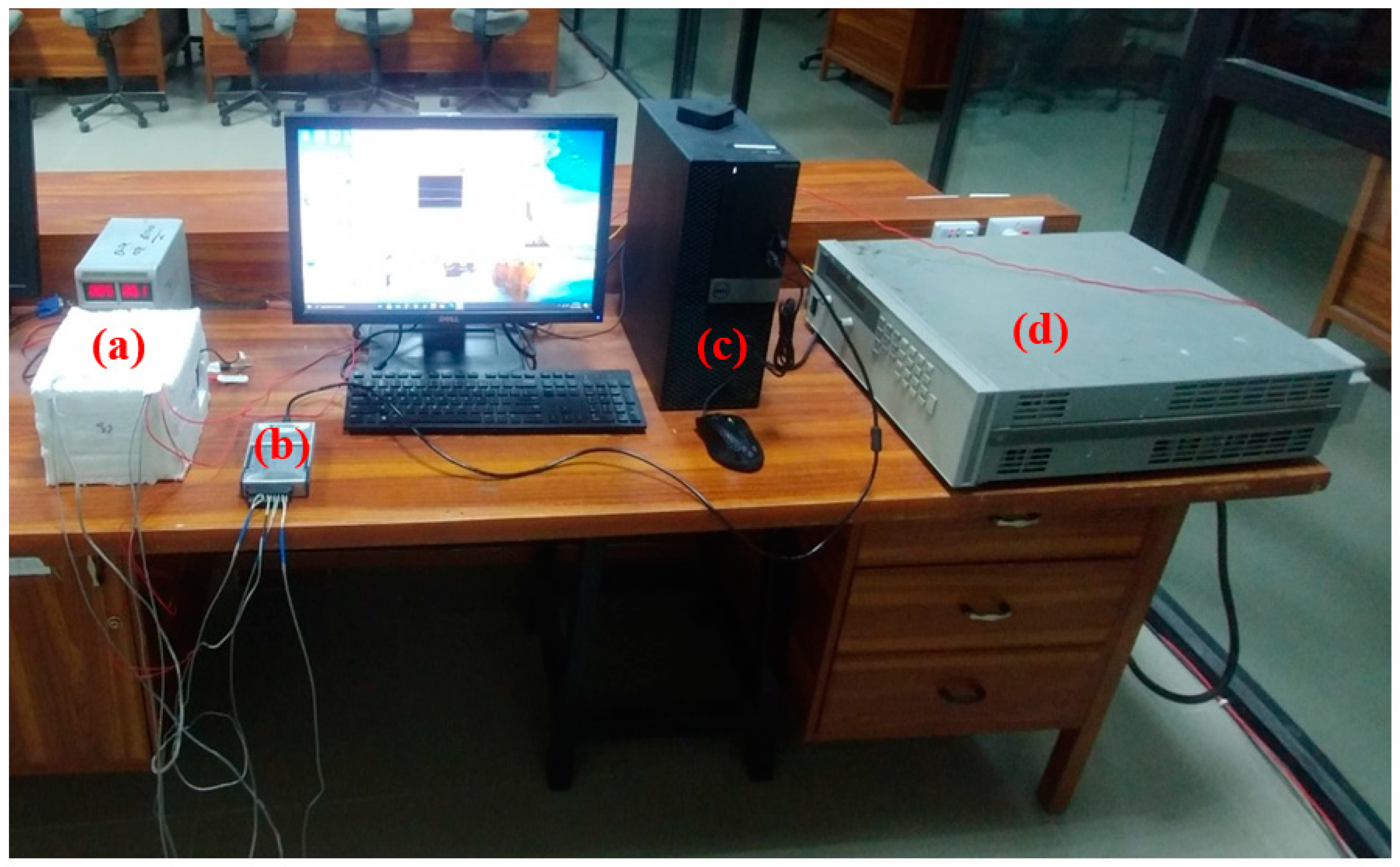

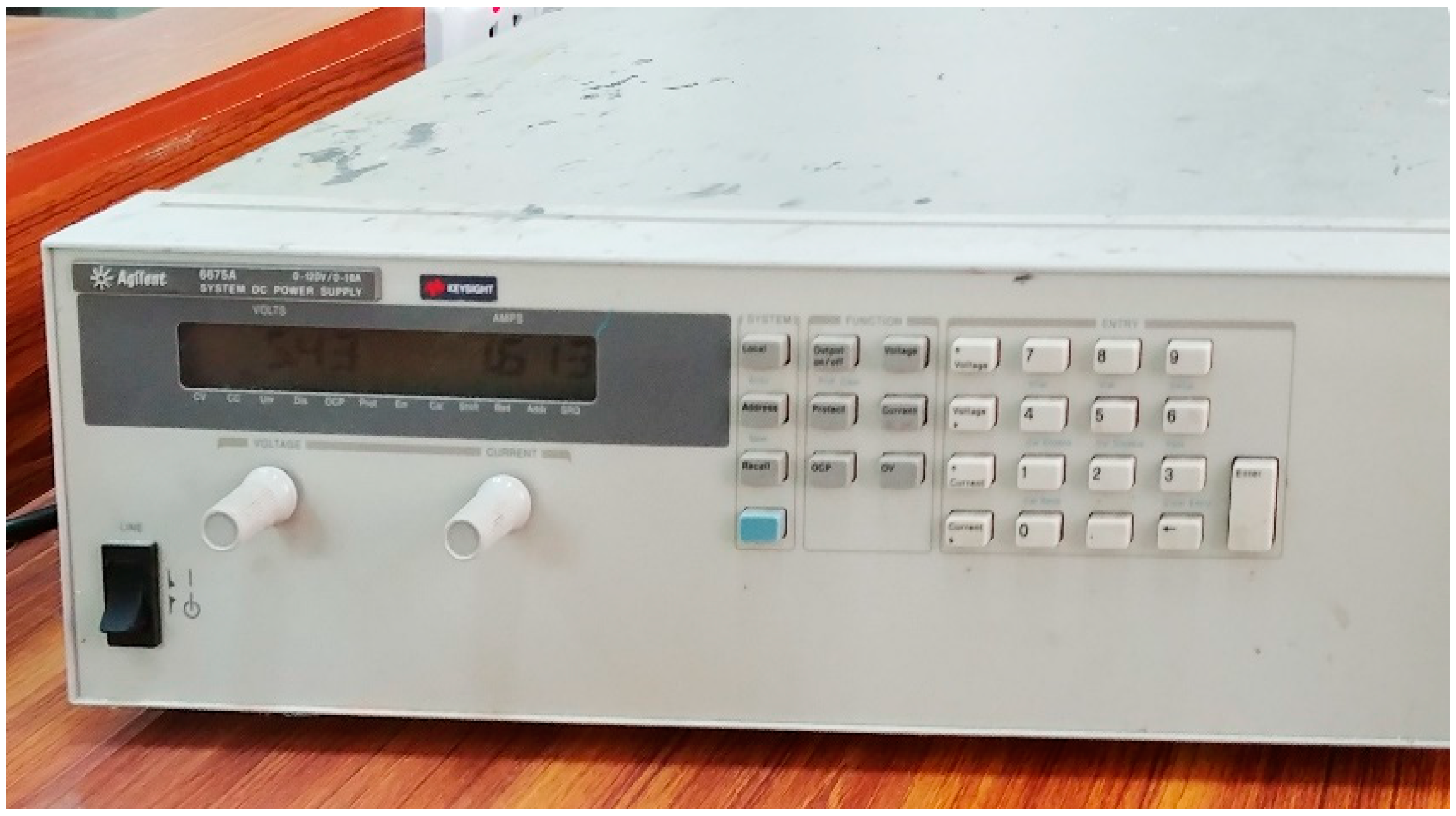
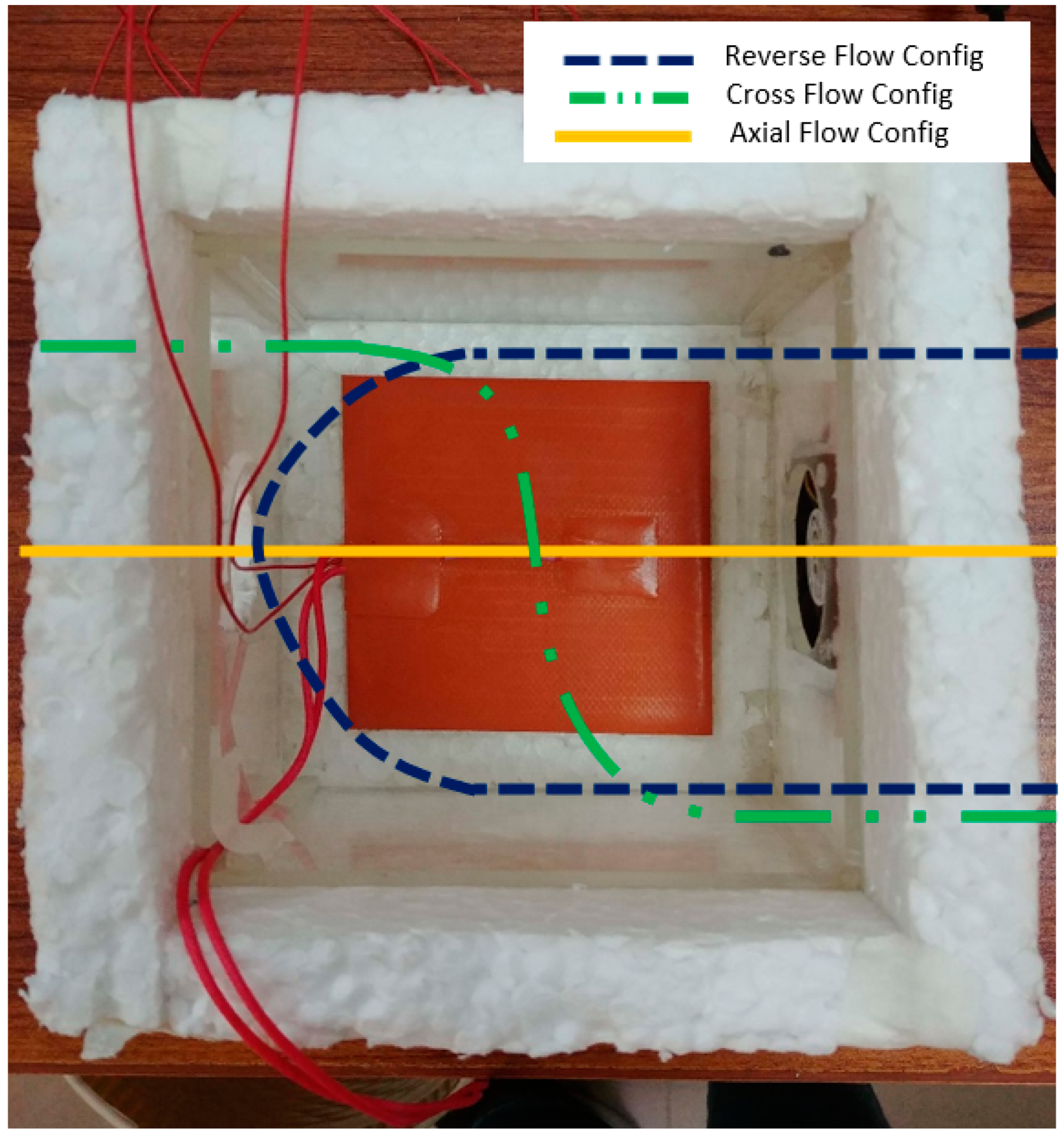
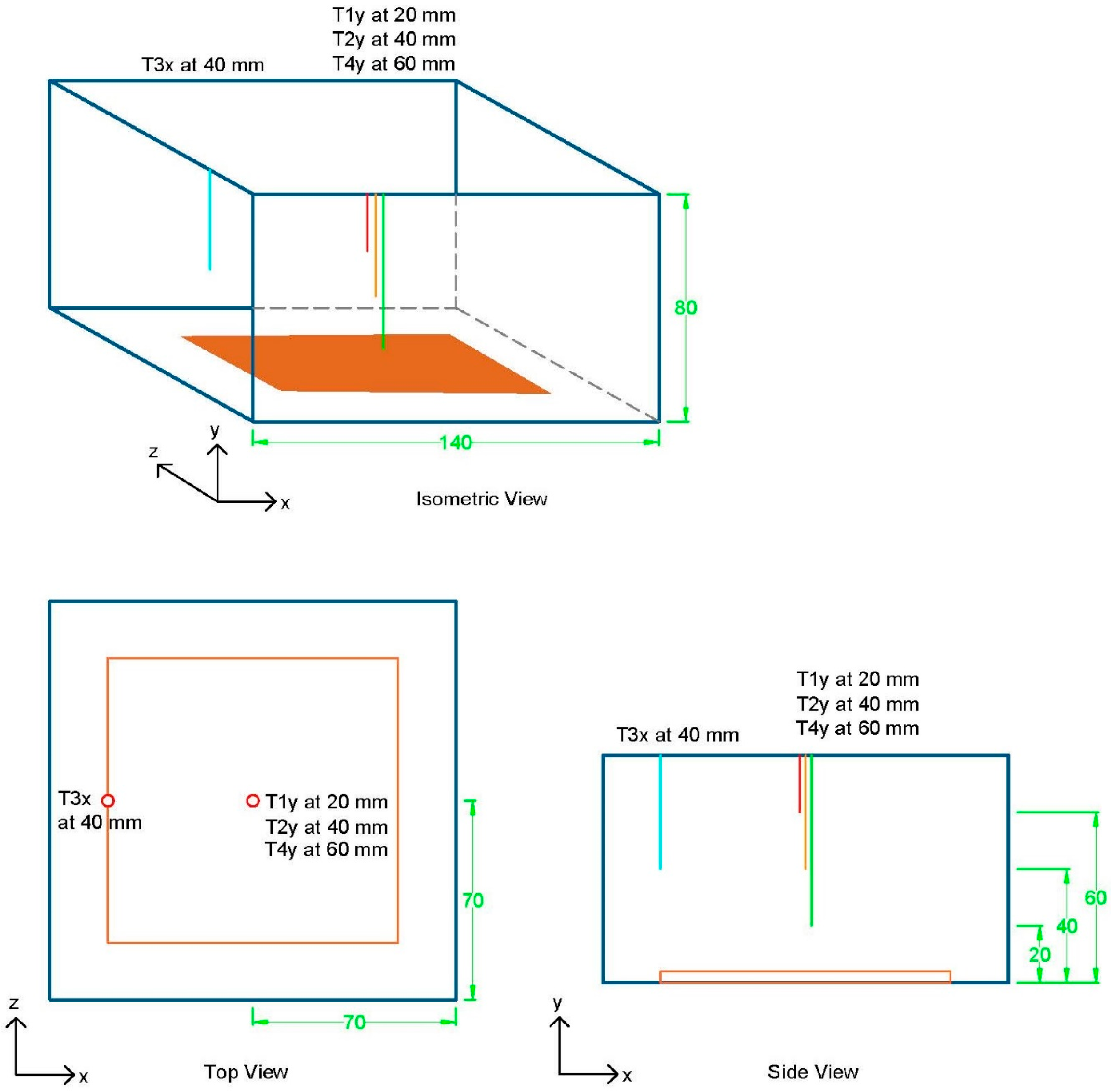
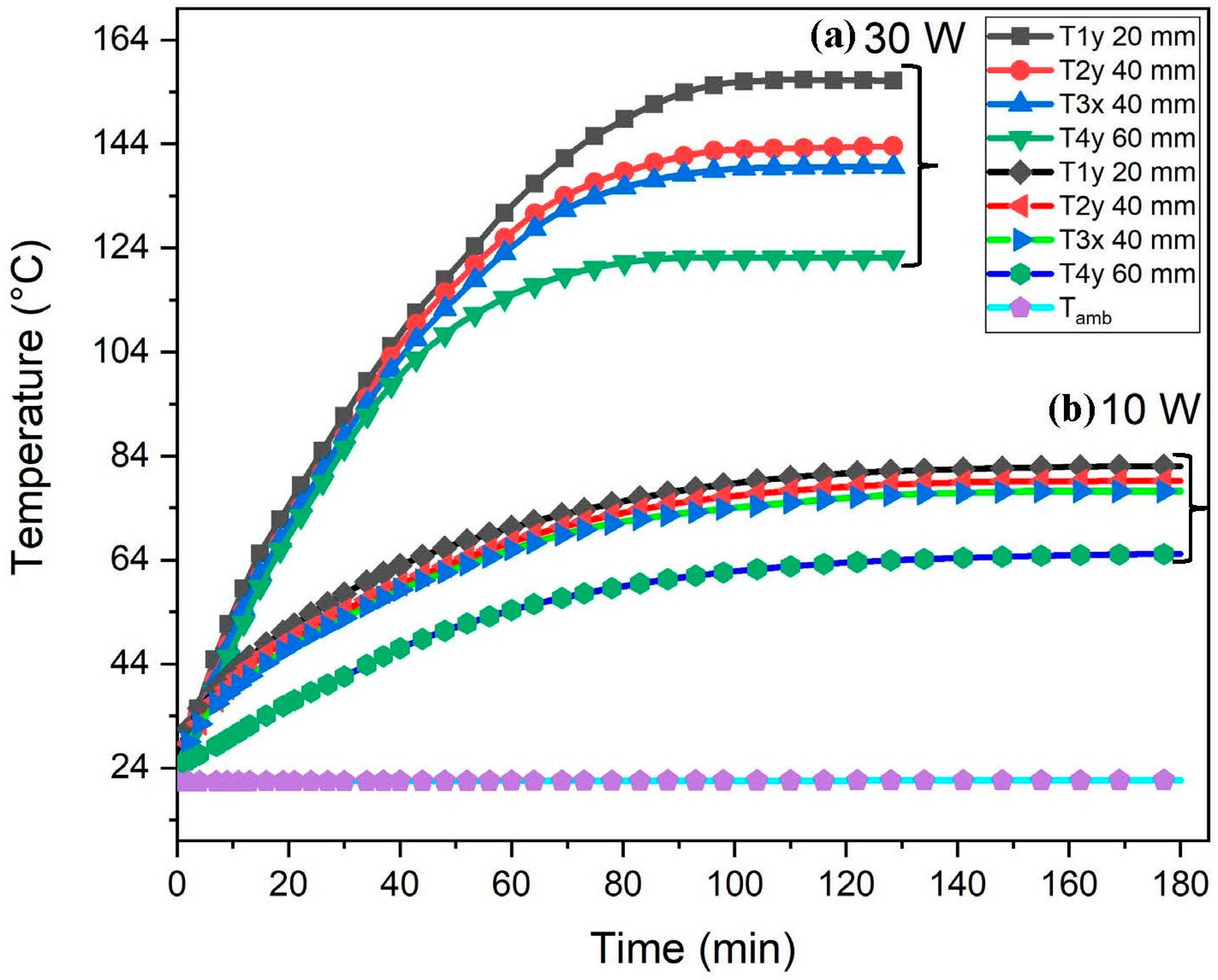

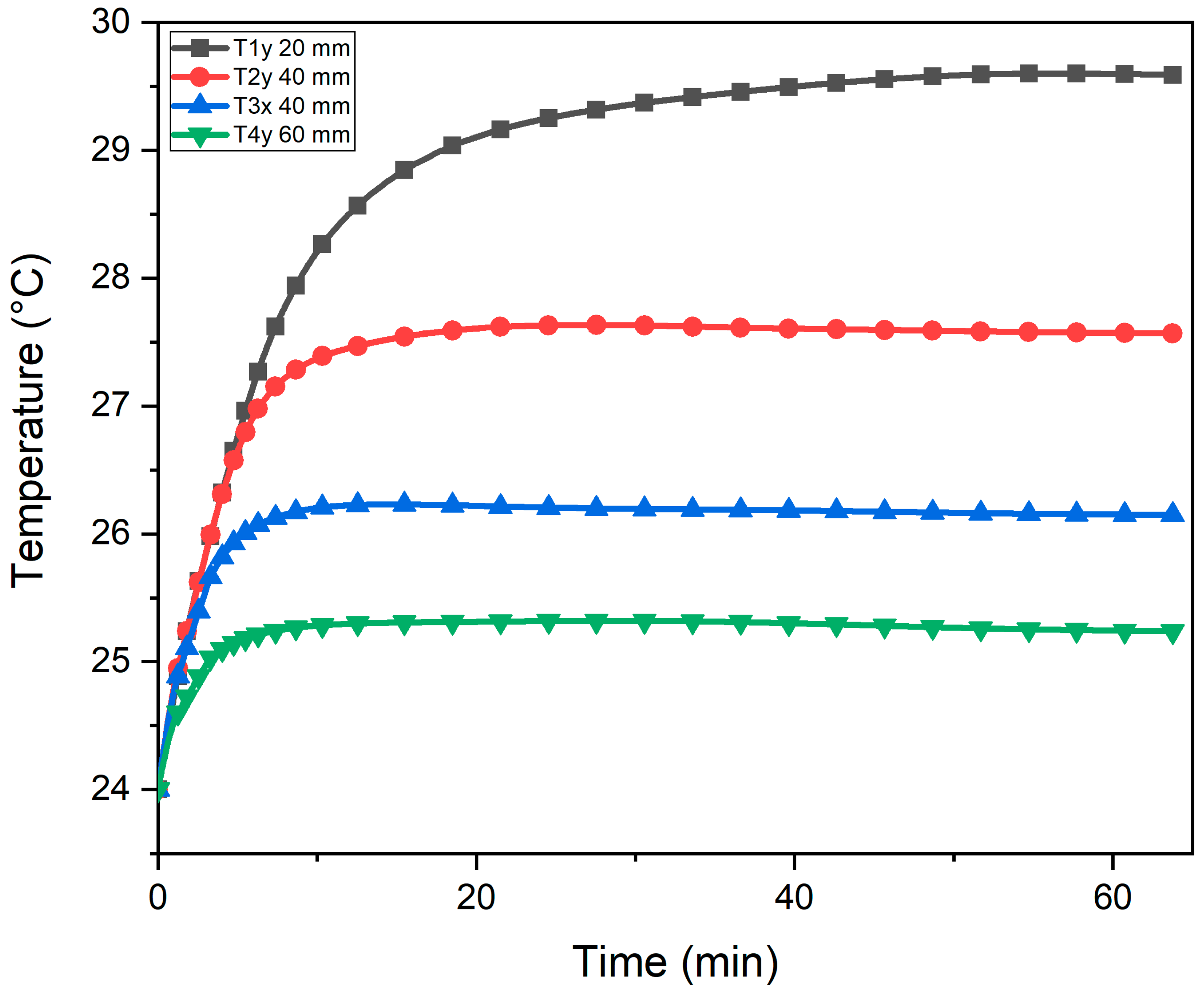
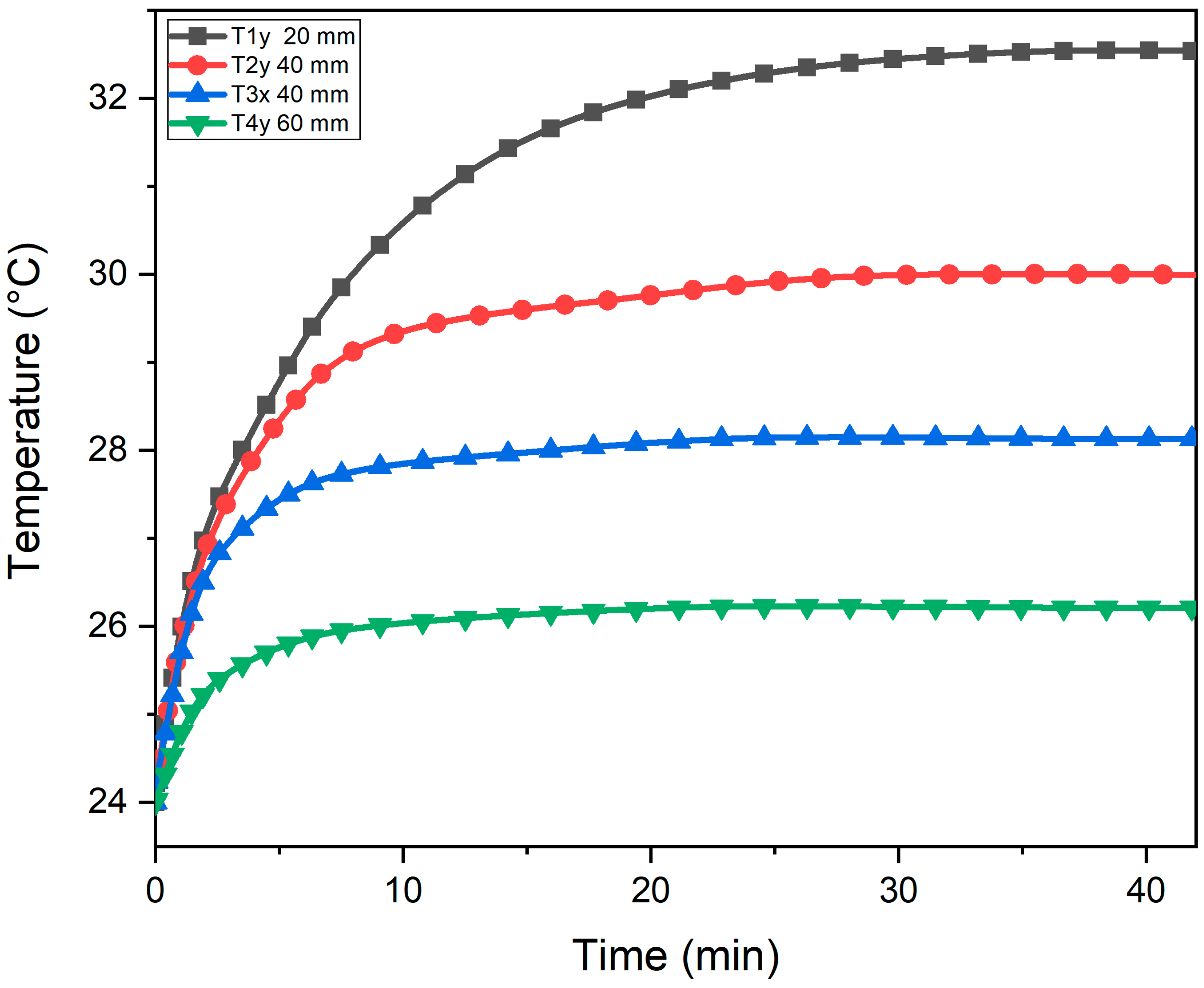

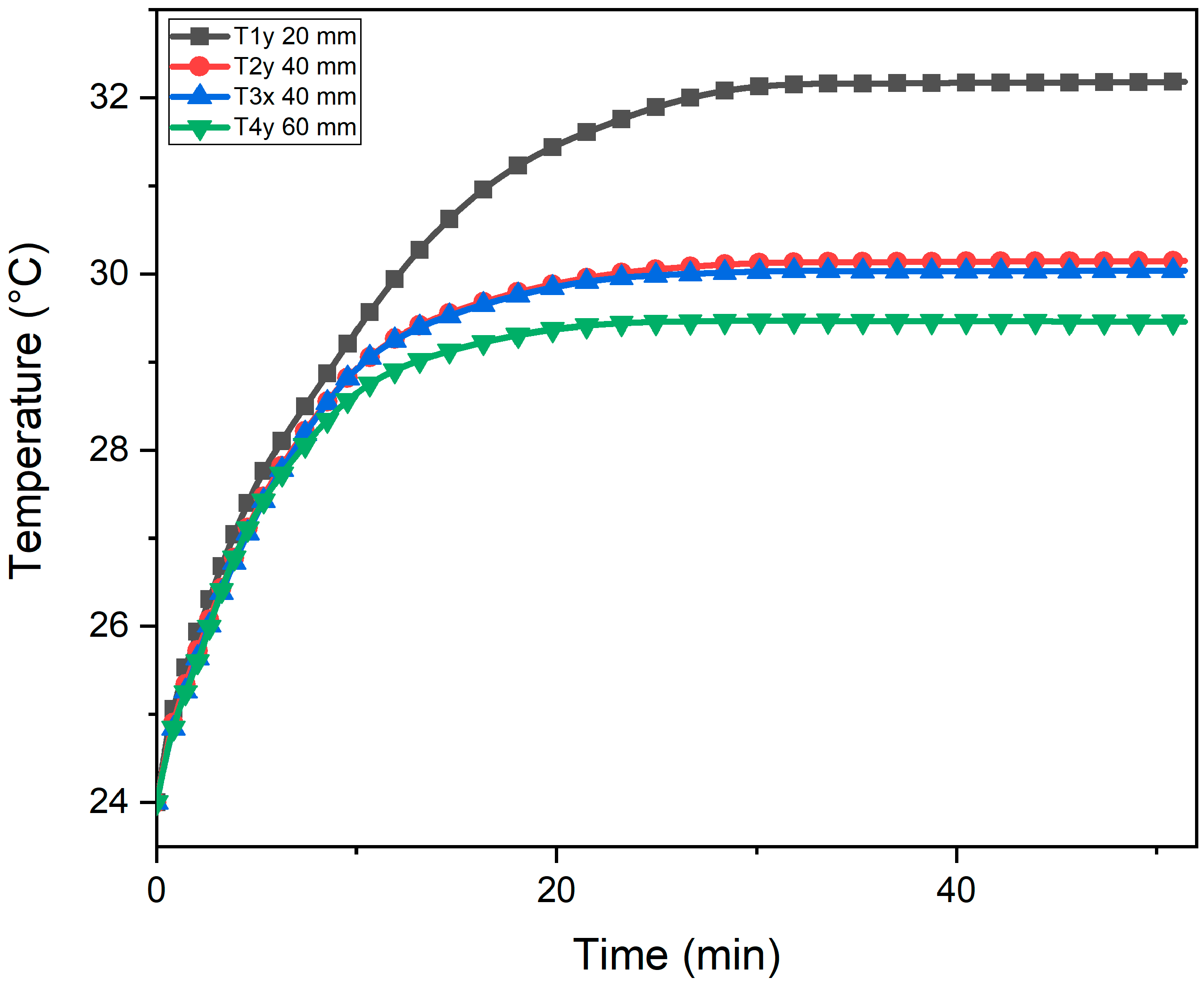
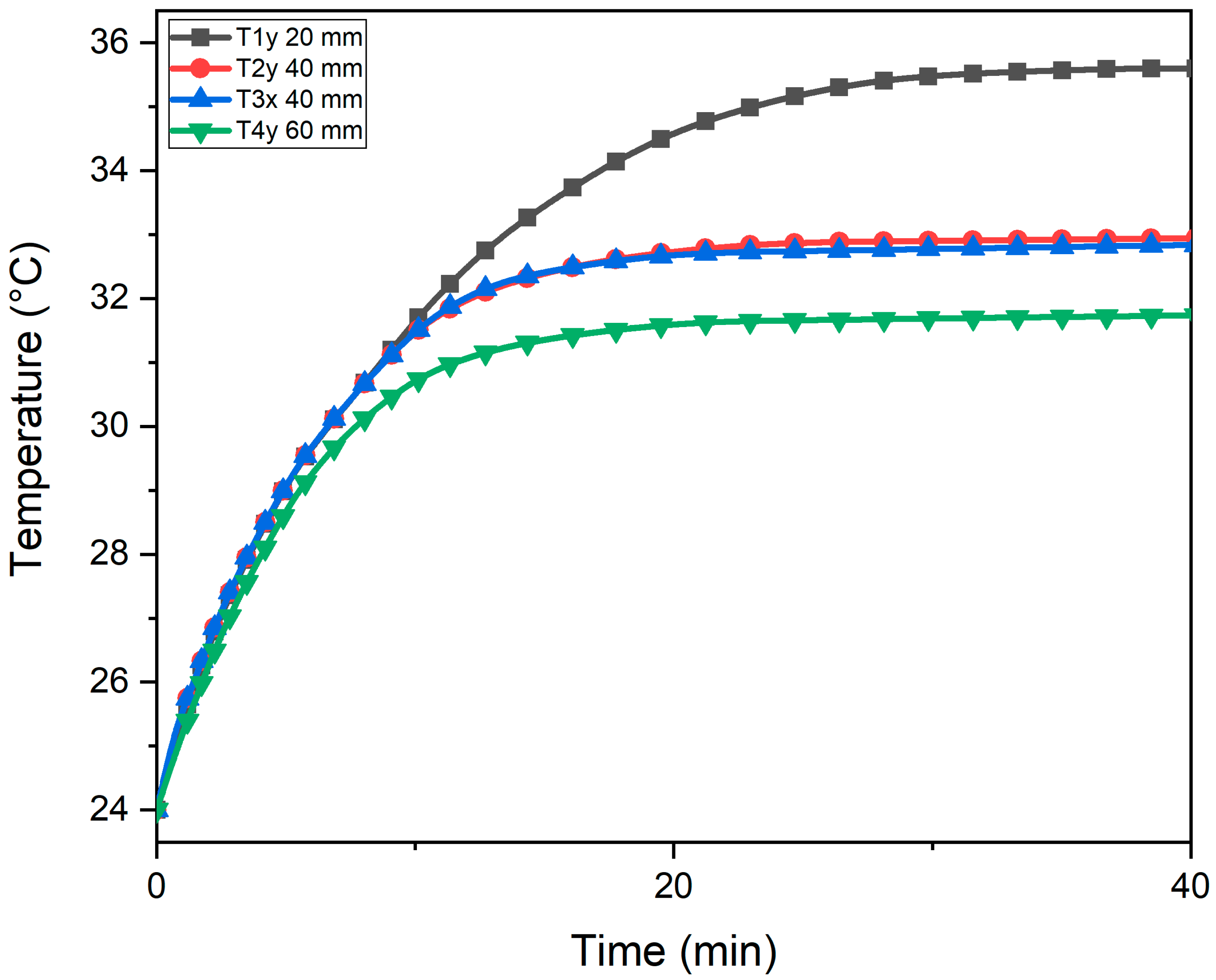

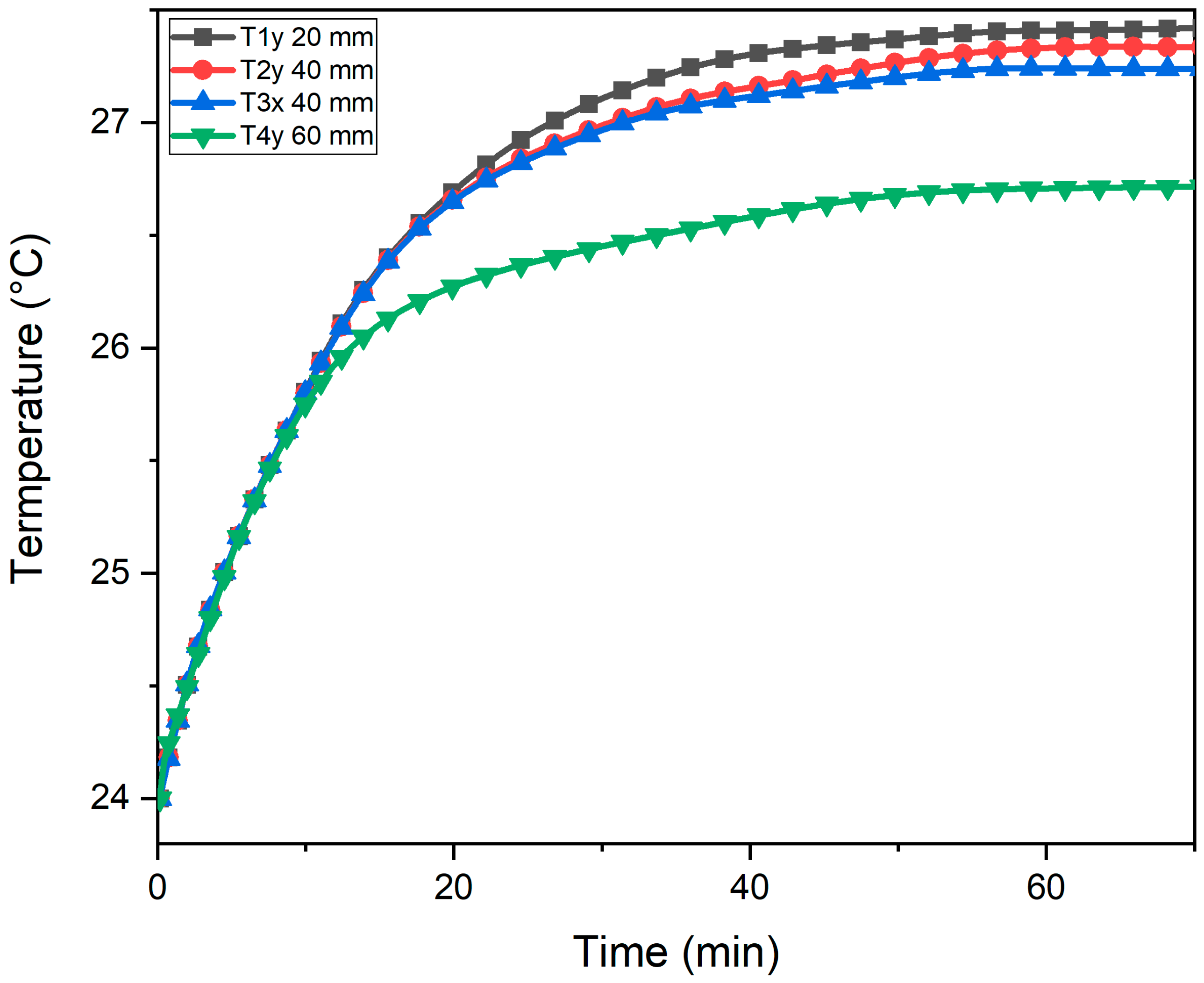
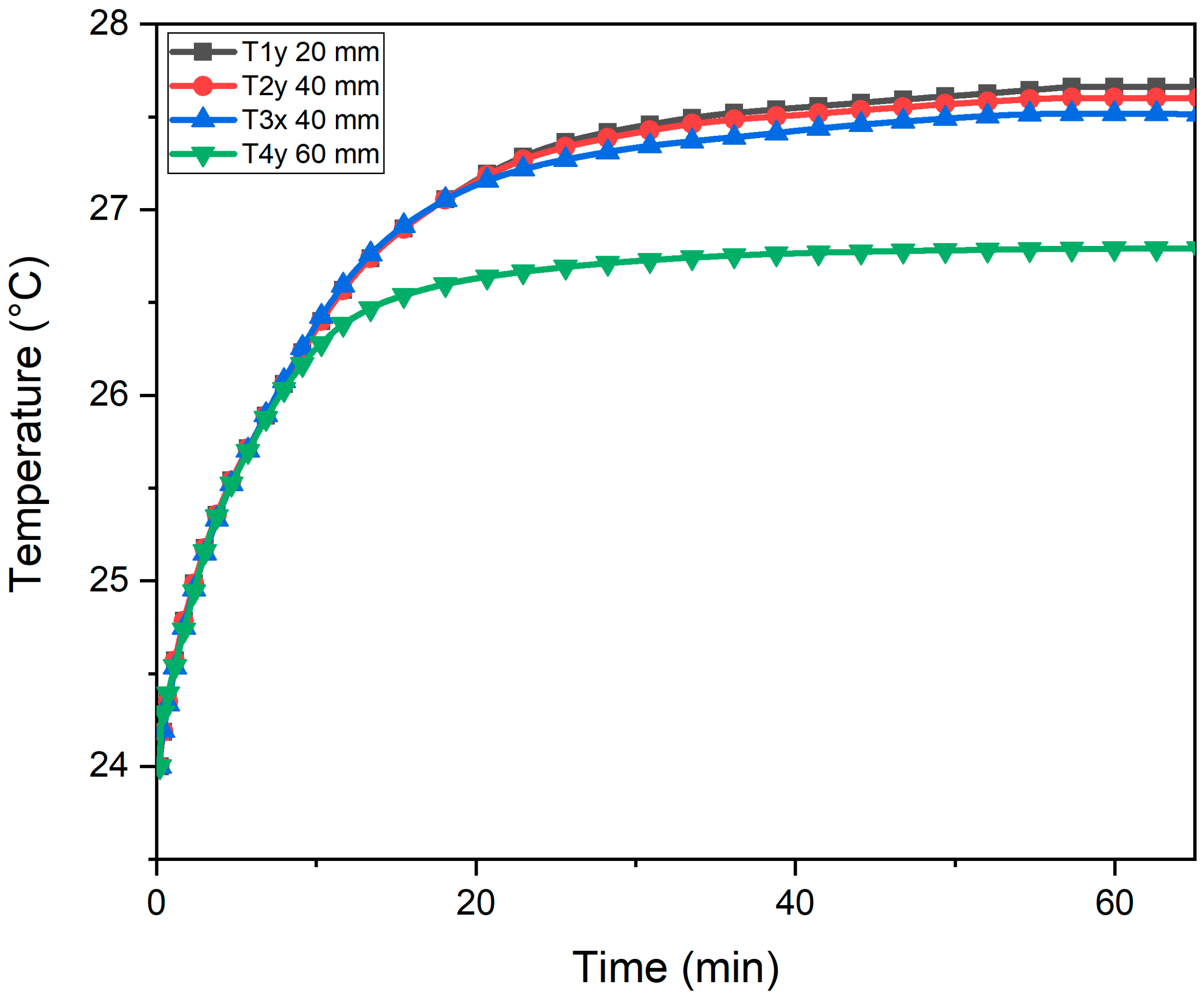
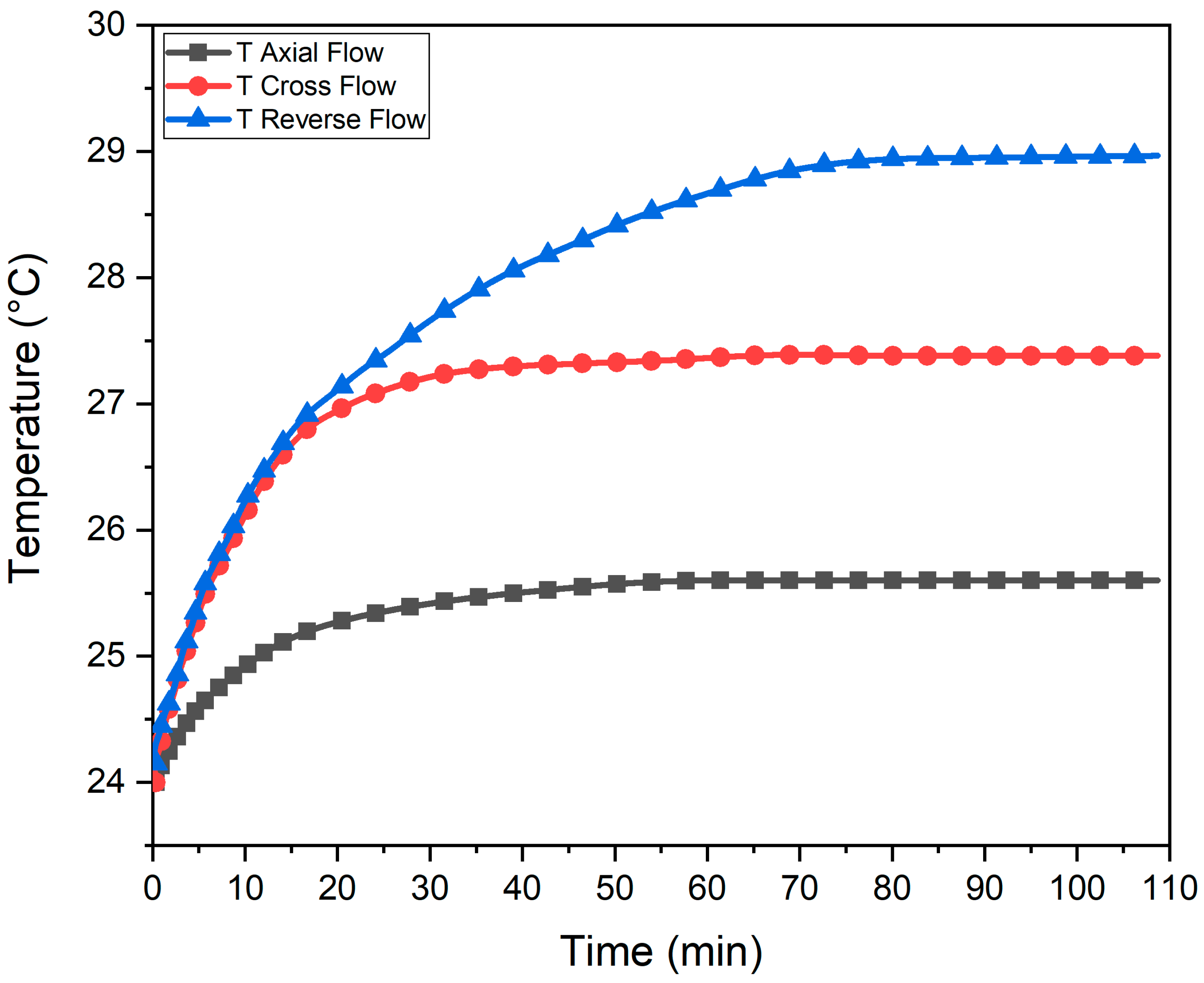
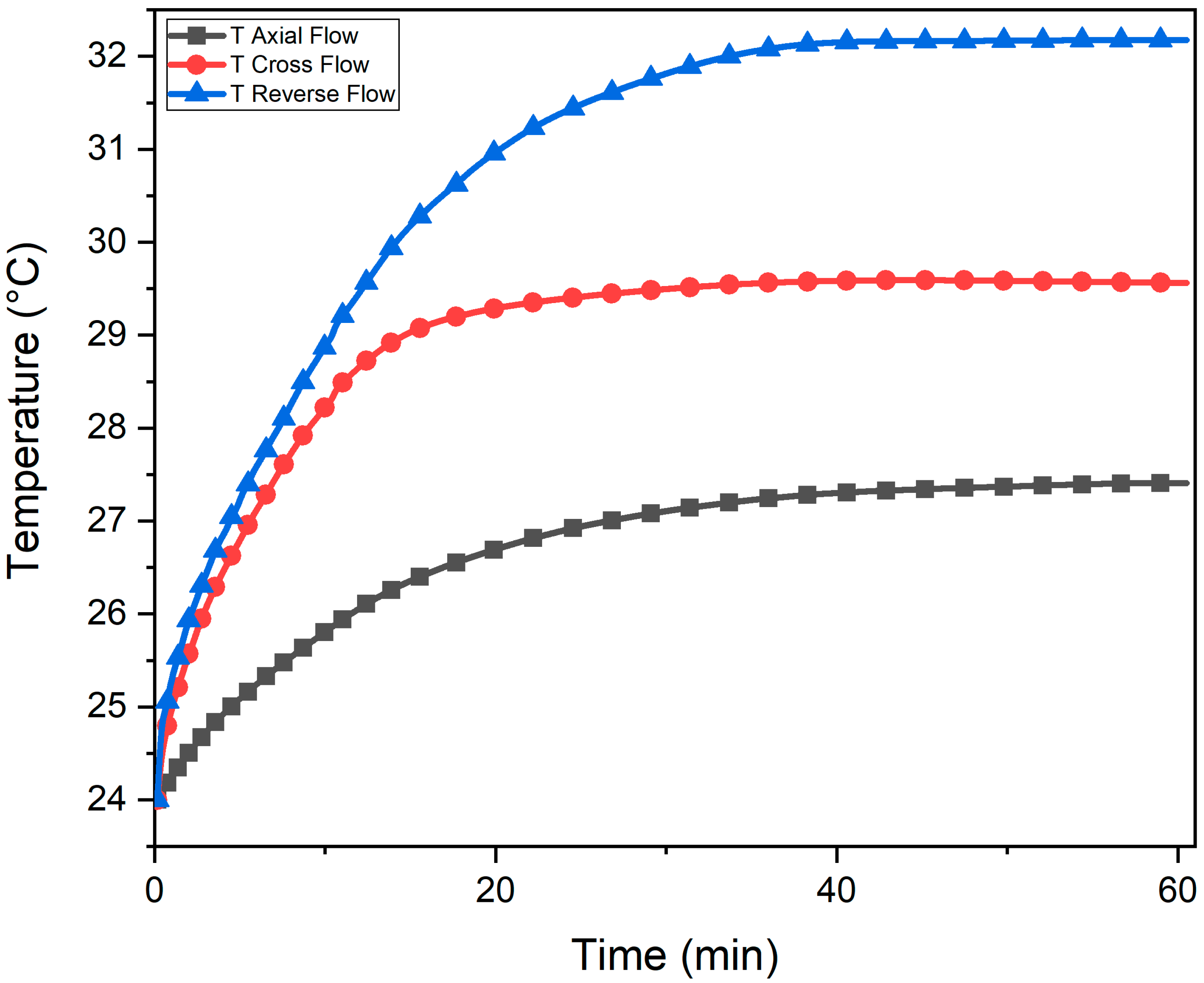
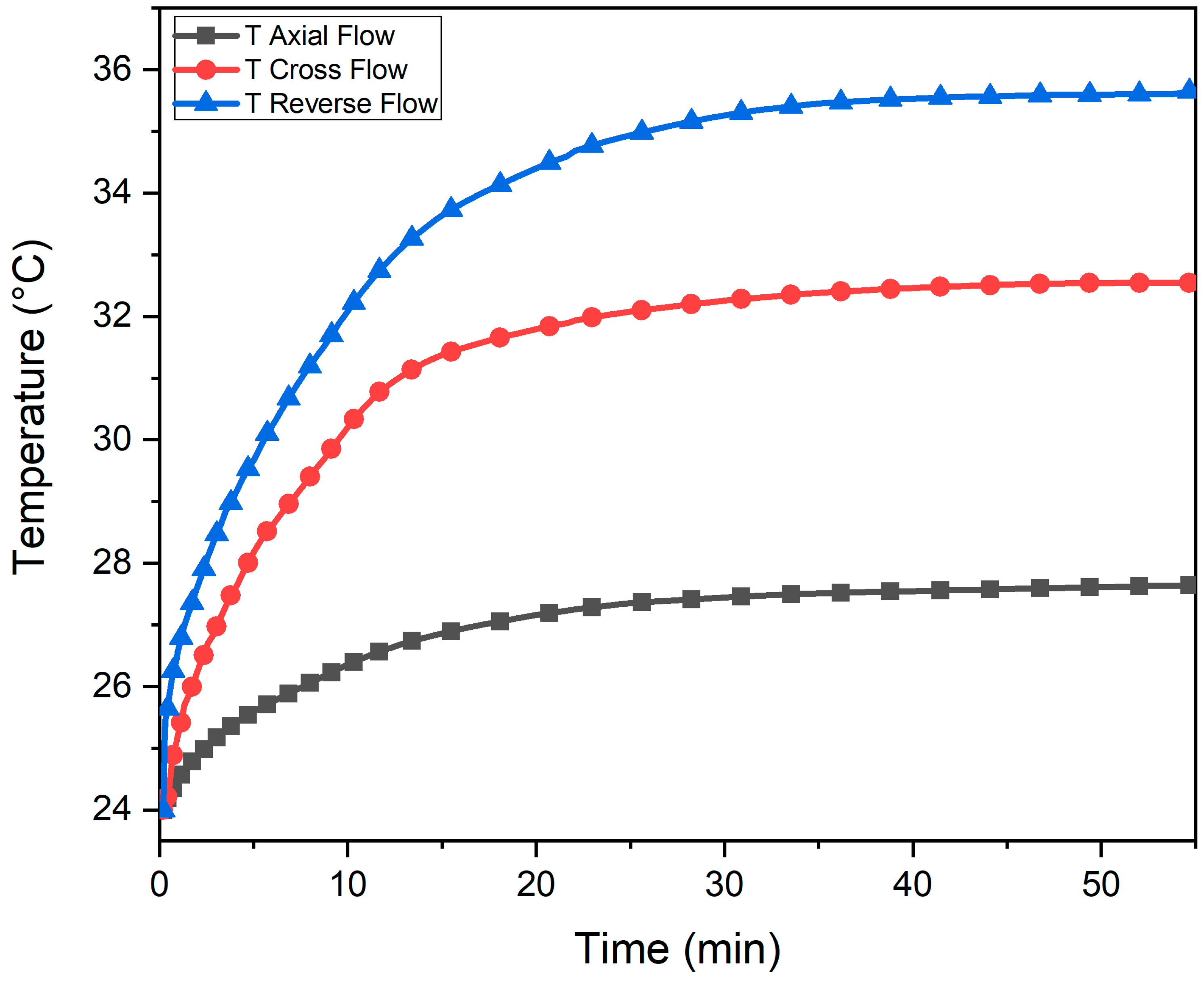
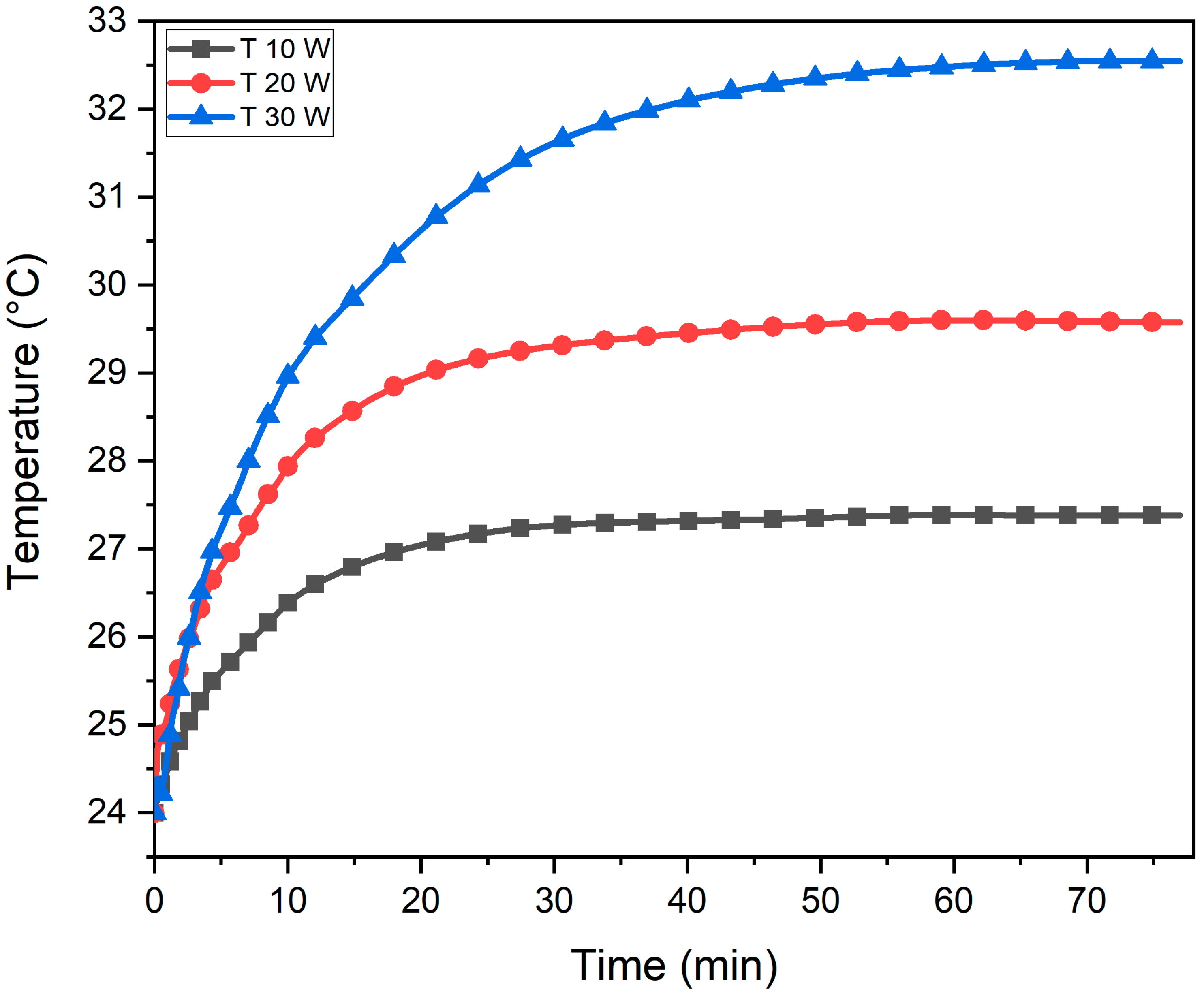


| Item | Power (W) | Voltage (V) | Current (A) | Resistance (Ω) | Temperature Range (°C) | Tolerance |
|---|---|---|---|---|---|---|
| Specifications | 50 | 12 | 4.1 | 2.88 | 155–160 | −/+10% |
| Parameter | Voltage Range (V) | Current Range (A) | Programming Accuracy | |
|---|---|---|---|---|
| Voltage | Current | |||
| Agilent 6675A | 0~120 | 0~18 | 0.04% + 120 mV | 0.1% + 12 mA |
| Power (W) | 10 W | 20 W | 30 W |
|---|---|---|---|
| q (kW/m2) | 1 | 2 | 3 |
| Item | Power (W) | Voltage (V) | Current (A) | Speed (R.P.M.) | Max Air Flow (m3/min) | Noise (db) |
|---|---|---|---|---|---|---|
| Specifications | 2.16 | 12 | 0.18 | 7400 | 0.572 | 38.5 |
| Item | Make | Type | Temperature Range (°C) | % Accuracy |
|---|---|---|---|---|
| Specification | OMEGATM | K-Type | −200~1250 | 0.75 |
Disclaimer/Publisher’s Note: The statements, opinions and data contained in all publications are solely those of the individual author(s) and contributor(s) and not of MDPI and/or the editor(s). MDPI and/or the editor(s) disclaim responsibility for any injury to people or property resulting from any ideas, methods, instructions or products referred to in the content. |
© 2023 by the authors. Licensee MDPI, Basel, Switzerland. This article is an open access article distributed under the terms and conditions of the Creative Commons Attribution (CC BY) license (https://creativecommons.org/licenses/by/4.0/).
Share and Cite
Saeed, S.; Hussain, A.; Ali, I.; Shahid, H.; Ali, H.M. Thermal Management of Electronics to Avoid Fire Using Different Air Flow Strategies. Fire 2023, 6, 87. https://doi.org/10.3390/fire6030087
Saeed S, Hussain A, Ali I, Shahid H, Ali HM. Thermal Management of Electronics to Avoid Fire Using Different Air Flow Strategies. Fire. 2023; 6(3):87. https://doi.org/10.3390/fire6030087
Chicago/Turabian StyleSaeed, Saad, Abid Hussain, Imran Ali, Hanzla Shahid, and Hafiz Muhammad Ali. 2023. "Thermal Management of Electronics to Avoid Fire Using Different Air Flow Strategies" Fire 6, no. 3: 87. https://doi.org/10.3390/fire6030087
APA StyleSaeed, S., Hussain, A., Ali, I., Shahid, H., & Ali, H. M. (2023). Thermal Management of Electronics to Avoid Fire Using Different Air Flow Strategies. Fire, 6(3), 87. https://doi.org/10.3390/fire6030087







